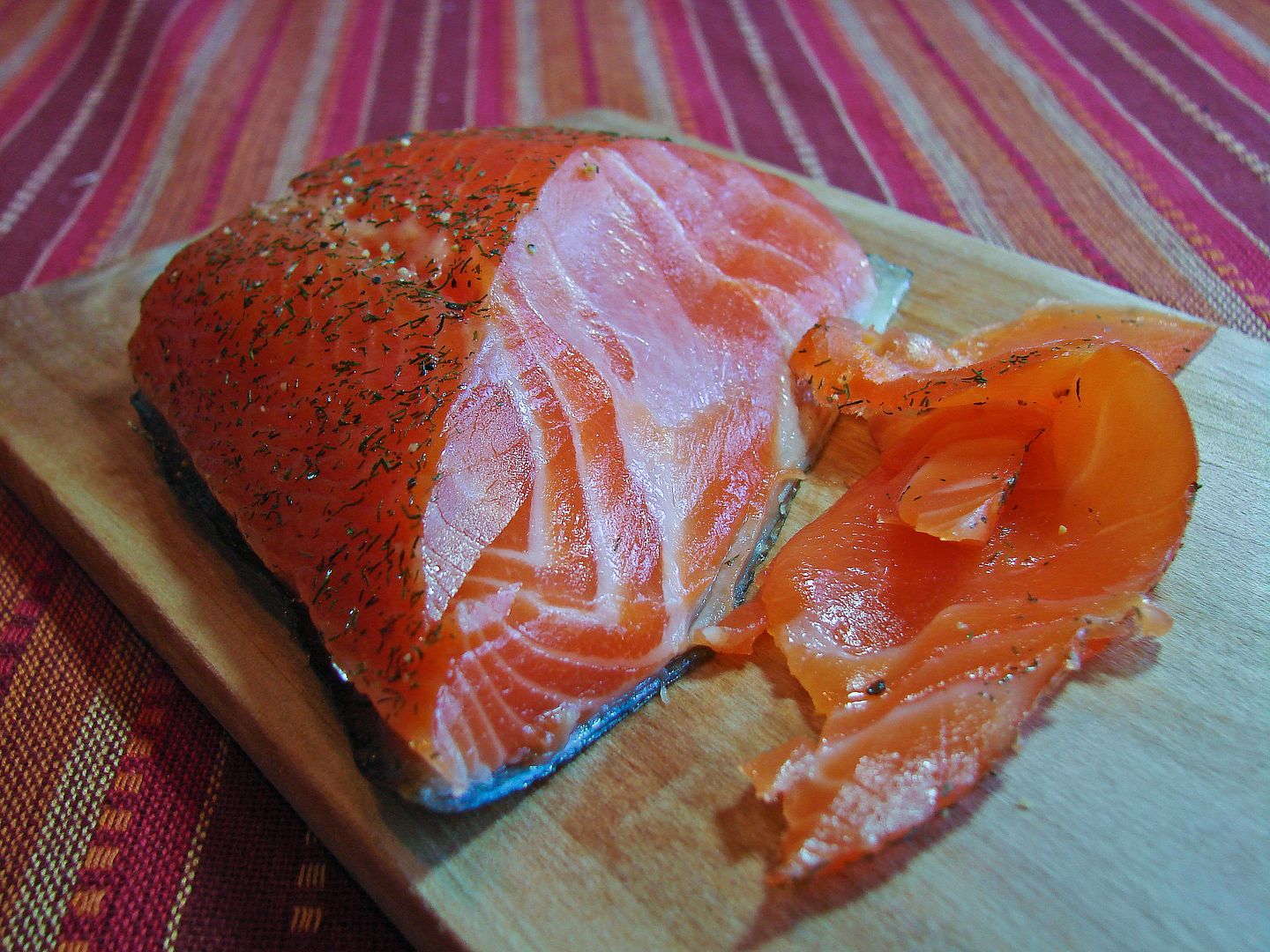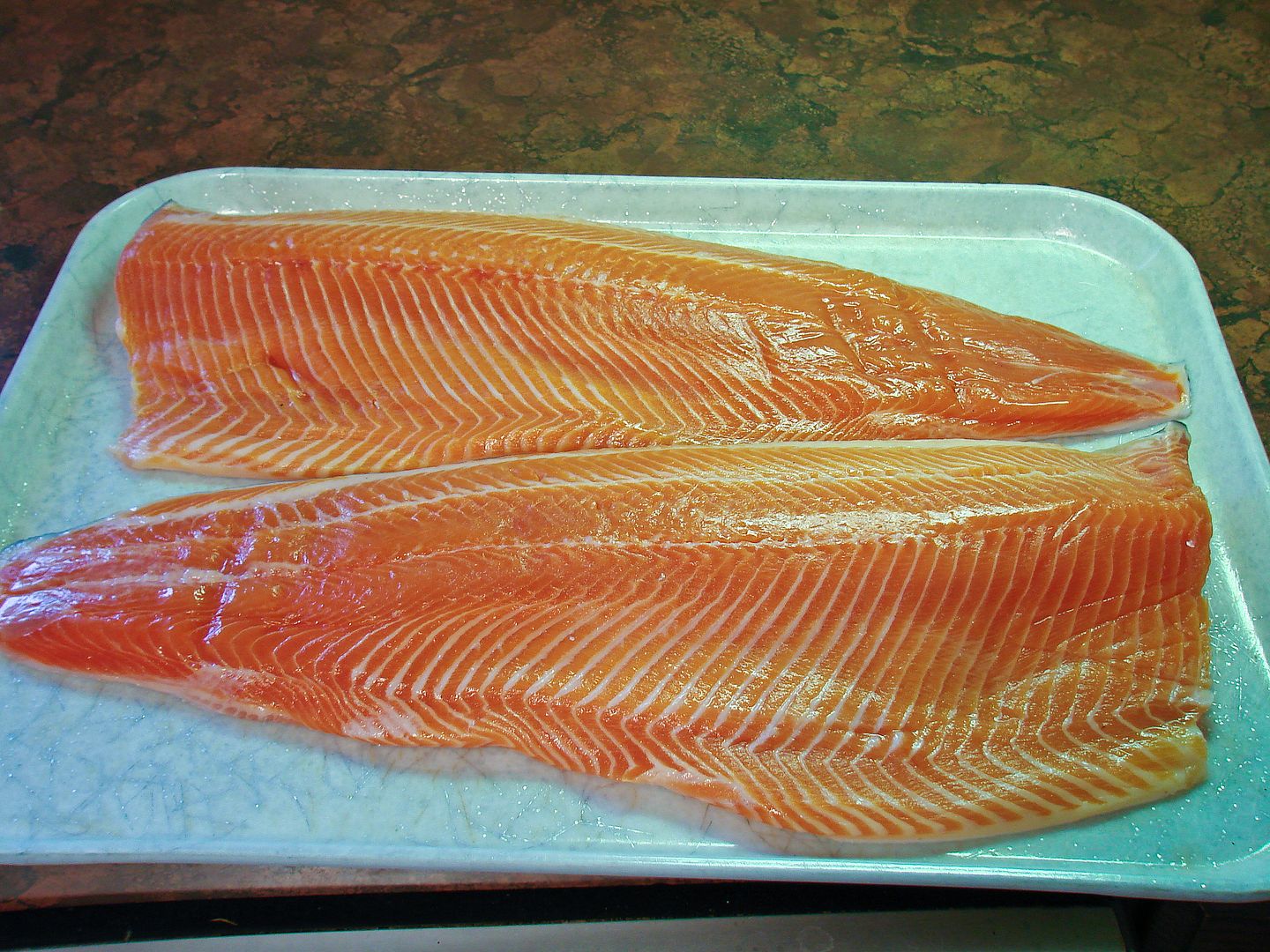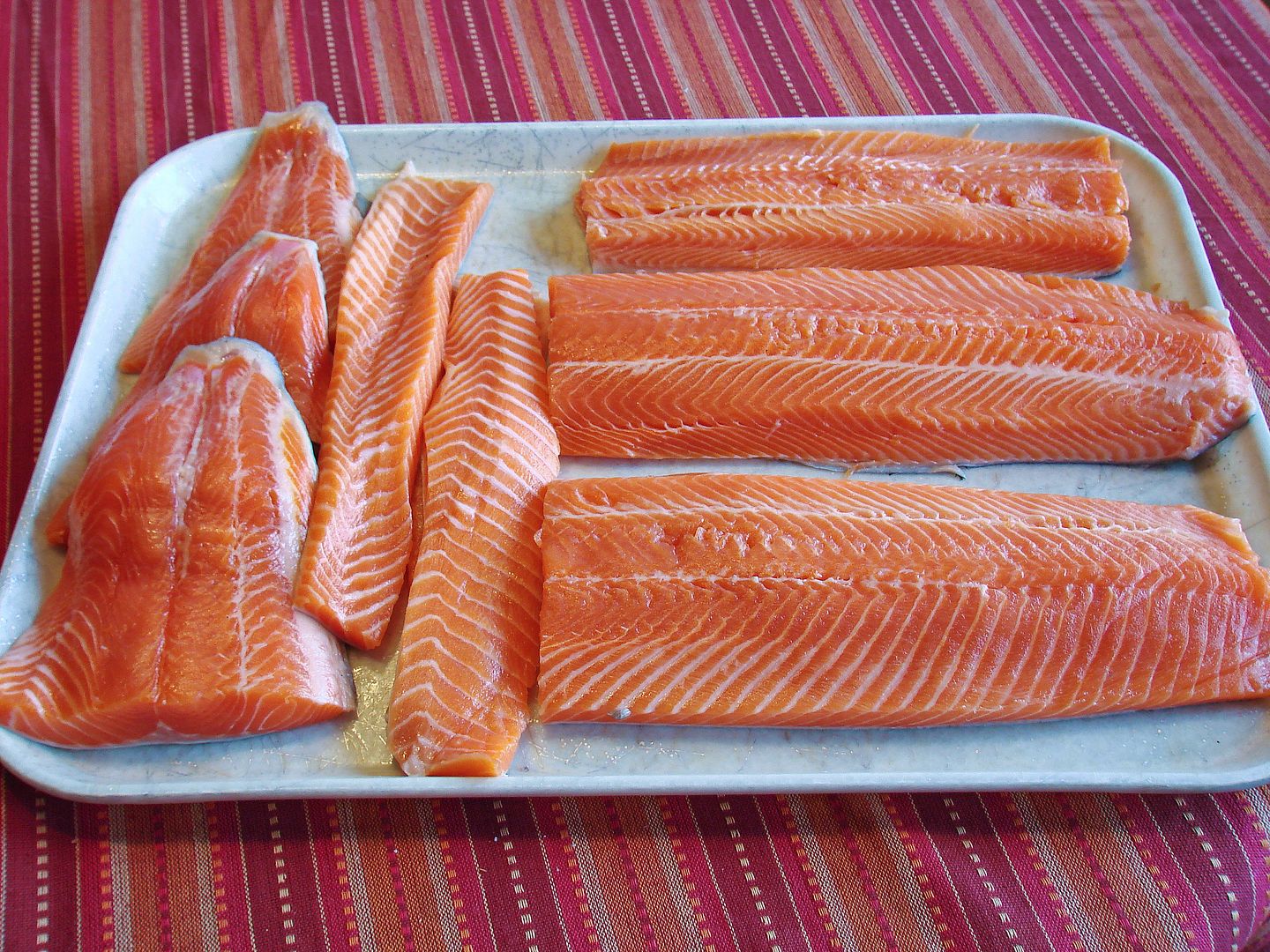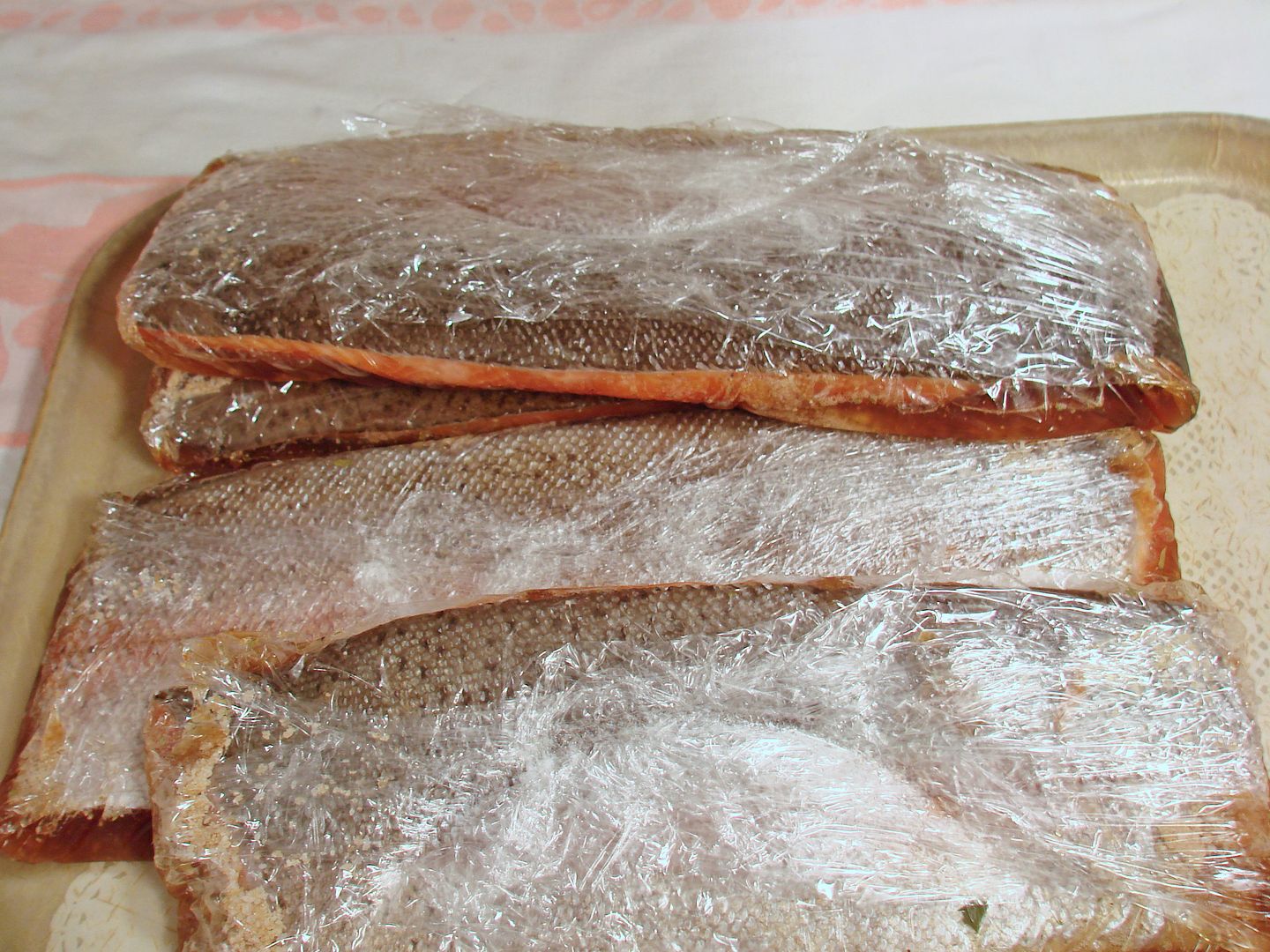If you are a regular reader you know I really field test any recipe, or technique before publishing it here. My technique for Nova Lox was developed from many sources and for well over a year I continued to refine my method. It's now December of 2012, and I'm ready to publish Revision 3, which I have been using for 11 months.

Fish: Salmon or Steelhead fillets, normal thickness, de-boned and skin-on. The fresher the better. I repeat..... the fresher the better. I suspect that larger trout fillets could also be used, but to date I have not utilized trout.
History: "Nova lox is less salty than other varieties of lox, and it should have a light smoke flavor." When developing my method below, I began working from descriptions like the one above of what Nova lox was to certain folks. And I sorted through a lot of descriptions, the funny thing was I discovered that Nova lox meant different things to different folks. Even my friend and Guest Pit Boss Lynne in Nova Scotia couldn't nail it down. Now, to some this would be a dead end street..... to me it was an education in preparing salmon which had ties to several cultures.
My research led me to numerous curing methods dating back more than 100 years. Many of these older methods used large quantities of salt, long curing times and required long soak-out times,…I reasoned they were sort of a carry-over from the days of “preservation curing” when refrigeration was not available to everyone. My goal was to keep some of the principles of the Nova lox methods intact, but utilize a modern approach with respect to the curing process, especially when it came to the amounts of salt used.
Unlike other techniques, my process uses a two-stage (or double) cure, two periods of overnight resting and 5 to 8 hours of cold smoking. This procedure takes about 60 hours from start to finish. The fish is in the refrigerator during the curing and for both overnight rest periods. I think a safe shelf life of the finished product is 4 to 5 days, although mine rarely lasts longer than 3 days. Contrary to the majority of lox recipes I found, I prefer some seasoning on my Nova lox, both for flavor and appearance. And I also like just enough of a distinct smoky flavor to overcome any issues folks might have with eating un-cooked fish.
PREPARATION OF THE FISH
Often food safety experts will recommend fish which has been commercially frozen when making lox. The quick freezing and well below zero temperatures will kill any baddies associated with uncooked fish you may worry about. That said, I prefer using extremely fresh fish which has not been frozen. I'll let you decide how to select your fish.
When starting with a whole side, I will remove the tail section and cut a strip off the belly section – this leaves a rectangular section that is somewhat uniform in thickness which will be used for lox. Run your fingers from the head end toward the tail end feeling for any small pin bones. Pluck them out with a pair of needle nose pliers. Rinse the fillet in cold water, then pat dry. Use a knife at 90° to the fillet and lightly scrape the surface of the fish... this will remove the little bit of flesh which was disturbed when the fish was filleted, and it will also close some of the gaps in the grain you may notice. (this is similar to lightly scraping any bone dust and loose fat off a steak or pork chop that was cut on a band saw)


Dry Cure – 10 to 12 hour cure time.
50:50 mixture kosher salt and brown sugar. (For a 7” long fillet I use 1/3 cup of kosher salt and 1/3 cup of brown sugar) Sprinkle a thin layer of the mixture onto a long piece of plastic wrap, the area should be slightly longer than each fillet. With the remainder of the dry cure, cover the surface of the flesh side of the fish (including the sides and ends), then turn the fillet flesh side down onto the wrap. Cure is not needed on the skin side of the fillet. Fold up the sides and ends of the plastic wrap forming a pouch, place fillet on a tray or platter in case the plastic wrap leaks. The skin side should be up.
Note: If you have any safety concerns regarding cold smoked fish (which is technically not cooked) you can add pink salt (Cure #1) to the salt/brown sugar mix. The proper amount is 2.5 grams for every 1000 grams (kilogram) of fish. This equals .25% and for the calculation, use .0025 for the multiplier. For example, if you had a 1 pound fillet (454 grams) the pink salt calculation would be: 454 X .0025 = 1.135 grams of pink salt.
Here are several fillets in the dry cure.

You can place a weight on the wrapped fillet to insure good contact of the salt/sugar mixture and the fish during the curing time. I use a small cutting board with a couple of cans of soda on it for weight. Cure time is 10 to 12 hours in the refrigerator. During the dry cure step the salt and sugar will liquefy and form a syrup. At the end of the cure time, remove the fish from the wrap, rinse under cold running water and lightly scrub the fish with fingers in order to remove the syrup and any un-dissolved sugar. The fish will be a darker red and feel slightly firm. Next, the fillets move into the wet (brine) cure.
Wet Brine Cure Recipe:
Large batch: 1 gallon of water, 10 ounces of salt and 1/2 cup of white sugar.
Small batch: 1 quart of water, 2.5 ounces of salt, 1/8 cup (or 2 Tablespoons) of white sugar.
Mix your brine ahead of time using warm water, then allow it to cool down in the refrigerator. Keep the brine in a non-reactive (plastic or glass) container. I like canning salt because it dissolves easier, but kosher will work. Whichever you choose, weigh the salt for accuracy. The white sugar will keep your brine really clear, its main purpose is to knock the bitter edge off the salt.
Brine Cure Time - 7 to 10 to 12 hours. Single fillets can be brined in a zipper bag. For larger fillets I use a small plastic bucket. The brine cure will make the texture of the fish relax, but will not wash out the color or cause the fillet be mushy. I prefer the 10 hour brine time unless I have thick fillets, then I go with 12 hours. A good tip would be to experiment with a couple of pieces and different brine times.
Soaking and Equalizing – 8 hours to overnight:
Soak-out: Rinse the fish under a gentle stream of cold running water from your faucet (this is called “freshening”) for 3 or 4 minutes. I put the fillet on a plate, flesh side up, and allow the water to flow across the meat. Next, soak the fillet in cold water for 4 or 5 minutes in a bowl or plastic bag. Freshening is an old technique which was used because early Nova Lox brines were very, very strong. (An alternate to freshening + soaking would be a longer soak-out, say 10 minutes)
Equalization : Dry the fillet with paper towels and place on a dry tray or plate. Use a small rack or a couple of chopsticks under the fillet. Do not cover the fillet. At this point the curing is complete and you have lox. It will need an overnight rest in the refrigerator to allow it to firm and to allow the salt to equalize within the fillet. Following the “equalization time” you can cut a thin slice to sample it for texture and flavor. Lox becomes Nova lox when it undergoes cold smoking. There are a variety of seasoning options including using no seasoning at all. I prefer to season the dried fillet lightly with white pepper, black pepper and dill weed before the overnight rest. I like the hint of seasoning combined with the light smoke.
Cold Smoking – 3 to 8 hours:
Background information: My current choice of equipment for cold smoking in the A-Maze-N cold smoking tray which can be used in almost any cooker provided you have adequate draft. It requires special sawdust and provides a gentle smoke for hours with almost no heat. No other heat source is used, the sawdust in the cold smoking tray is lit and the unit is placed inside your smoker. The fillets are placed on the smokers racks.
Prior to using this method I used a Big Chief box smoker, but the Big Chief created more heat due to its hot plate smoke generator. Ideally the temperature of the cold smoker should be below 100 degrees. I would often unplug the Big Chief several times while cold smoking to allow it to cool down, or fill a pan full of ice below the rack of fish to help cool the smoke. On several forums I have seen positive comments about using a soldering iron placed through a hole in a tin can containing some wood chips, but I have not tried out this method.
Cold Smoking Method: I prefer an Apple/Hickory mix of sawdust in the A-Maze-N cold smoking tray. Smoking time is a personal preference and the style of smoke generator you use as well as the draft characteristics of the smoker have a big impact on flavor delivery. The only way to determine the correct amount of smoke flavor is to experiment the first time you make Nova lox. Cold smoke the fillet for 1-1/2 to 2 hours, then removed the fillet and sample several thin slices. Use additional smoke time as needed.
My Smoking Times: Spring, summer and fall - I can tell you when using my Smokey Joe “tallboy” smoker, my cold smoke times are around 3 to 4 hours. The draft is different in my Big Chief so I need more like 4 to 5 hours of cold smoke time.
During the winter I set up the A-Maze-N cold smoke tray in my Big Chief and found by plugging in the burner for 15 minutes every hour I could raise the temperature of the box from 30 degrees to 70 degrees. (I was afraid the 30 degree temperature would be too low). My winter cold smoking time was around 5 hours.
Second Smoke Option: Sometimes I have removed my Nova Lox from the cold smoker and chilled it for an hour or two, then sampled. Sometimes it needs a little more smoke flavor.... no problem, just return it to the cold smoker for another dose of flavor. An hour or two usually does the trick.
Preparation For Eating – Overnight Rest Recommended: After cold smoking, the Nova Lox needs to mellow overnight in the refrigerator to have the best flavor. The chilling also allows for easier slicing. Make the slices as thin as possible, and serve them on a chilled plate. The texture can be described as “candied”, and the smoke and salt should be noticeable but subtle. The amount of saltiness can be adjusted by more or less time in the rinse/soak step. Smoke flavor is adjusted by wood selection and/or cold smoke time.